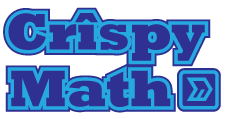Trig Speed
/After my students measured the Unit Circle using the worksheet I adapted from Riley. We spent a class period or so figuring out all of the «nice» coordinates around the circle. A few kids vaguely (to my dismay but not surprise) remembered special right triangles, and so I made sure that we (mostly students at the board doing the heavy lifting) derived these from scratch. Once we filled in the coordinates all the way around the circle. I also introduced them to angle measure in radians and had the kids work in small groups to find all of these. This was fun because different groups were developing different strategies to figure out the angles and the room was buzzing with the discovery of new new strategies and approaches. Once we figured out all the angles we went through the entire diagram again from scratch and I asked the students to spend a few minutes seeing if they could figure out strategies to reproduce our unit circle quickly since next class we would have a quiz.
The first unit circle quiz day is always a good time because students come in and I ask them if there is a new pop song they want to hear and they inevitably choose something obnoxious and this works out perfectly. This year one of the girls chimed in and said «Just play anything by Taylor Swift!» I could not ask for more. «I Knew Your Were Trouble» it was. The quiz works simply, students keep the worksheet facedown until the song begins and need to finish it before the song ends. It turns out «I Knew Your Were Trouble» is 3:40 seconds. More than enough time for the unit circle. Maybe even two.
Maybe you are thinking «Why do I torture the kids this way!» Haha. Well I am not out to torture them. I tell them straight up I am preparing them to be trig experts in the IB (that they will pursue next year) and that being able to quickly produce this unit circle will get them great results. Every year students come back from previous years to tell me how much it helped. And the students find it fun. I do give the students a grade for the assignment, but not until the third time through (unless they think they finished it) and their low grades can be straight up replaced as students can finish the task. After each daily quiz I have students partner up with a peer to figure out errors and strategize, and then if necessary we work together as a class to clear up any class wide concerns. I encourage everyone to try to improve their score. If you are now thinking «Well why would you memorize anything?!» Then I suggest this great article from Wired back in 2008.
I still, of course, haven't brought up the idea of cosine and sine, but students are more and more mentioning SOHCAHTOA and I am more and more insisting they must mean CAHSOHTOA.








